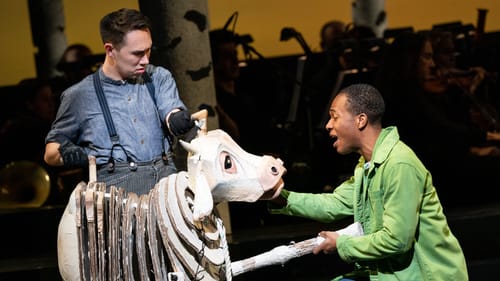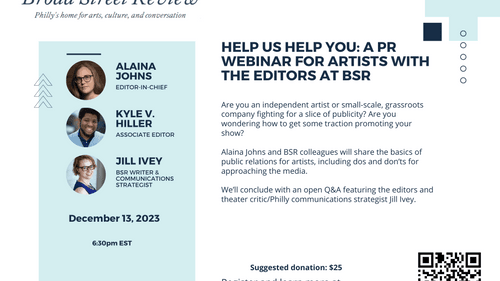Stay in the Loop
BSR publishes on a weekly schedule, with an email newsletter every Wednesday and Thursday morning. There’s no paywall, and subscribing is always free.
Going backstage at BSR: The PR connection
BSR Behind the Scenes: What does public relations have to do with arts journalism?

To close out 2023, BSR is taking you behind the scenes. From claims that journalists are just in it for the money and the clicks (please, show me some of this money) to complaints that BSR is undermining the entire theater industry because a critic penned a negative review (seriously, you should see my inbox), we’re realizing that a lot of people don’t understand the realities of working in the media today, particularly arts media. And why would they if we don’t explain it to the public?
Unlike a lot of arts organizations, BSR doesn’t have a public-relations team of our own. But in the spirit of making our work more transparent, we want to shine a light on the role of PR in our field—and what recent changes in arts PR might say about the arts sector and its relationship with you.
What can PR people do—and not do?
As a reader, you might not ever know the names of the professionals working on Philly’s arts PR scene the way you can name the artists, arts institutions, and the journalists who cover them. Often, when we write about a show, PR folks have invited us, cooked up story ideas and photo ops, coordinated our tickets, personally welcomed us to the venue, provided us with all the necessary factual and dramaturgical materials, and/or scheduled and sat in on interviews, plus speedily answering our extra questions or finding someone who can.
Does that mean PR folks control what we write or which stories we tell? Nope. Particularly in the case of reviews, they have no idea what the journalist is going to say. But they do their jobs in good faith, trusting that whatever we write will be based on the facts and our own well-informed opinions—even if it’s not the opinion their client was hoping for. Regardless of the outcome of any individual story, the best PR folks build relationships with journalists, forming a critical link between the artist and audience.
PR folks are always coming up with ideas to keep the work they are promoting in front of potential ticket-buyers: that means, for example, bringing cast members from Cirque du Soleil into the city to cavort on Philly landmarks—and making sure the media is there to take pictures. It’s why I get emails like this: “Media Alert for Tuesday: Milky White from Broadway's INTO THE WOODS to ‘trot’ up the Art ‘MOO-seum’ steps.”

Arts PR is changing
What used to be “press night” (usually opening night, when the critics come to review) is now “press and influencer night.” PR folks are smart to make that pivot and reach potential audiences on social media; there are many creators who don’t have traditional credentials, experience, or audiences but are providing valuable info and insight for their followers. (When a section of I-95 collapsed in North Philly earlier this year, Governor Josh Shapiro’s office was smart to invite viral TikToker Alex Pearlman, @Pearlmania500, as well as traditional media outlets to the press conference, reaching constituents where they are.)
This is not the only major shift in PR happening right now, and it’s not the one that worries me. Several years ago, it was common for regional arts institutions to have at least one PR person on staff—someone who knew the organization, its artists, and just as importantly, local media outlets, someone who was not just promoting a single event, but who has a longer-term knowledge of the institution and how we have covered it. But that is changing. Many arts organizations have cut their in-house PR and have hired either a local independent contractor to promote individual shows or an out-of-state PR firm.
What’s the harm in that? From my desk, it’s frustrating when local PR folks who are, by necessity, juggling too many clients cannot give us the timely help we need. But it’s even worse when, for example, a New York City firm whose associates have clearly never read BSR bombard us with irrelevant or wrongly targeted coverage requests or cannot follow through on the basic materials we need. PR is about relationships and the exchange of relevant information, not throwing everything at the digital wall and seeing what sticks.
Who is responsible for this change?
I’m not trying to criticize PR folks, who have one of the most unrelenting and thankless jobs in the biz, without curtain calls or the cachet of a byline. Rather, I want to point out an apparent decline in investment at the institutional level. Whether it’s because of a budget squeeze or the false sense that good PR is dispensable, it seems that many local arts organizations are not investing the way they used to in these workers.
We see it from our desks, not just because of the overloaded contractors or glut of emails from ham-handed, impersonal firms, but in how often local professionals are moving. Nowadays, it’s increasingly rare to deal with one PR person for the length of a season at any given institution—they arrive and depart in a matter of months. Instead, members of the media play hopscotch with our contacts, trying to figure out who can help us when we need access on behalf of our readers.

PR folks are not more flighty than other workers in the sector. When some companies (like many regional theaters) have artistic or production staff that remain in their roles for decades while the PR folks (often like the artists themselves) get a revolving door of hectic contracts, it’s clear from my desk that companies are not investing equally in all parts of their operations.
Why should you, the reader, care?
There’s a parallel here that involves you. Like I said earlier, trust in media is in decline (and this is not just a right-wing phenomenon). Arts coverage in particular is shrinking precipitously in our region and around the country. As arts coverage disappears, maybe it’s logical for institutions to stop prioritizing the professionals who connect them to the media. Though, I would argue the opposite: as opportunities for coverage contract, you need savvy, committed PR people all the more.
Plus, writing off the fourth estate only worsens the social and political crises we face. This applies to arts journalists, too, who play an important role in holding influential cultural institutions accountable for whom they empower and represent, and how, and why. Arts journalists also play a crucial role in connecting people to their neighbors, encouraging them to go to local events and support local creators. This reduces polarization and increases community goodwill and investment.
When arts institutions reduce their investment in PR and thus their investment in media coverage, what they’re really reducing is their investment in you, their patrons—and not just your knowledge of their events, but your access to substantive critique of the institutions and their work.
Continuing the conversation
To me, this deterioration in arts PR both reflects and perpetuates a more fractured world. Can institutions expect these professionals to do their best if they aren’t supported properly? Can they hire just anyone to effectively tell their story to the press, especially when that person is not part of the community and has no prior relationship with the people in it, including the journalists? This is an all-too-familiar split between the self and the story, the real world and how we package it. But PR in the hands of knowledgeable, well-resourced locals is a win for the institutions, the media, and the ticket-buyers.

I hope this piece has offered you some new insight into how we, as arts journalists, do our job. In the coming weeks, look out for two more editorials taking you behind the scenes of our work. (Friends get early access!) And, if you want to continue this conversation about arts PR, join us for our Wednesday, December 13 webinar, HELP US HELP YOU: A PR Webinar for Artists with the Editors at BSR, which is free for our Friends and open to everyone else with a $25 donation.
Sign up for our newsletter
All of the week's new articles, all in one place. Sign up for the free weekly BSR newsletters, and don't miss a conversation.

 Alaina Johns
Alaina Johns